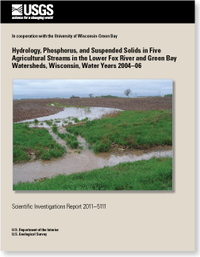Hydrology, phosphorus, and suspended solids in five agricultural streams in the Lower Fox River and Green Bay Watersheds, Wisconsin, Water Years 2004-06
Links
- More information: USGS Index Page (html)
- Download citation as: RIS | Dublin Core
Abstract
The overall median total suspended solids (TSS) concentration was highest in Baird Creek (73.5 mg/L), followed by Apple and Ashwaubenon Creeks (65 mg/L), East River (40 mg/L), and Duck Creek (30 mg/L). The median total phosphorus (TP) concentration was highest in Ashwaubenon Creek (0.60 mg/L), followed by Baird Creek (0.47 mg/L), Apple Creek (0.37 mg/L), East River (0.26 mg/L), and Duck Creek (0.22 mg/L).
The average annual TSS yields ranged from 111 tons/mi2 in Apple Creek to 45 tons/mi2 in Duck Creek. All five watersheds yielded more TSS than the median value (32.4 tons/mi2) from previous studies in the Southeastern Wisconsin Till Plains (SWTP) ecoregion. The average annual TP yields ranged from 663 lbs/mi2 in Baird Creek to 382 lbs/mi2 in Duck Creek. All five watersheds yielded more TP than the median value from previous studies in the SWTP ecoregion, and the Baird Creek watershed yielded more TP than the statewide median of 650 lbs/mi2 from previous studies.Overall, Duck Creek had the lowest median and volumetric weighted concentrations and mean yield of TSS and TP. The same pattern was true for dissolved phosphorus (DP), except the volumetrically weighted concentration was lowest in the East River. In contrast, Ashwaubenon, Baird, and Apple Creeks had greater median and volumetrically weighted concentrations and mean yields of TSS, TP, DP than Duck Creek and the East River. Water quality in Duck Creek and East River were distinctly different from Ashwaubenon, Baird, and Apple Creeks. Loads from individual runoff events for all of these streams were important to the total annual mass transport of the constituents. On average, about 20 percent of the annual TSS loads and about 17 percent of the TP loads were transported in 1-day events in each stream.
| Publication type | Report |
|---|---|
| Publication Subtype | USGS Numbered Series |
| Title | Hydrology, phosphorus, and suspended solids in five agricultural streams in the Lower Fox River and Green Bay Watersheds, Wisconsin, Water Years 2004-06 |
| Series title | Scientific Investigations Report |
| Series number | 2011-5111 |
| DOI | 10.3133/sir20115111 |
| Year Published | 2011 |
| Language | English |
| Publisher | U.S. Geological Survey |
| Publisher location | Reston, VA |
| Contributing office(s) | Wisconsin Water Science Center |
| Description | vi, 28 p. |
| Country | United States |
| State | Wisconsin |
| Other Geospatial | Lower Fox River Watershed;Green Bay Watershed |
| Additional Online Files (Y/N) | Y |


